For anyone starting on their poker journey, there are plenty of facets of the game to learn . Betting, bluffing, pot equity – they’ll all appear at some point or another as you learn the game and become familiar with its rules and strategies.
Before you learn almost anything else however, there’s one vital aspect to the game you must know: the hands rankings. It’s the most basic part of the game and the most important, as it forms the basis for everything you might learn afterwards Quite simply, learning hand rankings is something the new player can’t ignore.
There’s good news when it comes to hands rankings, as you can learn them easily. There are only 10 different types of hands you can get in poker, and they’re all pretty easy to both understand and remember. This means that you’ll easily be able to tell a full house from a royal flush quickly, after which you can get on with learning more advanced strategies and skills that top poker players need to understand.
How to Form Different types of hands
The most popular form of poker in the world is Texas hold’em , by some distance. This means that we’ll be concentrating on Texas hold’em throughout this page. The first thing to learn, even before the order, is how to form a hand when you’re playing.
In Texas hold’em, you’ll be dealt two cards, which are unique to you, plus there are also five cards dealt into the middle of the table, which can be used by everyone. You then have to get the best five-card, essentially meaning that you’re discarding two cards.
Here’s an example: you’ve got A-K in your hand, and the cards 2-J-Q-5-10 are dealt. In this situation, your best combination would be 10-J-Q-K-A, meaning that you’d discard the 2 and the 5. It takes some time working out hands at first, however you’ll become faster the more you play.
Hand Rankings: What Beats What?
Now that we know how to create a hand in Texas hold’em poker, let’s take a look at the official hands ranked. The hands listed below go from best to worst, and they start with the number one hand order – the royal flush.
Royal Flush

This is the best hand in poker, however it’s incredibly rare to see – some experienced players have never managed to hit one. It is formed when a player gets 10-J-Q-K-A, all of the same suit.
The rarity of this suited 10 J Q K A cards combination is what makes it so highly coveted and celebrated among poker players. It's a hand that sits at the top of the hand rankings, surpassing other strong hands like straight flushes and four of a kind.
The odds of hitting a 10-J-Q-K-A Royal Flush are astronomically low, making it a once-in-a-lifetime event for many poker enthusiasts. This rarity adds to the allure and excitement of the game, as the potential for such a hand, however slight, keeps players on the edge of their seats.
Moreover, the Royal Flush is not just a symbol of luck; it represents the ultimate achievement in a game that blends skill, strategy, and chance. When a player is fortunate enough to get this hand, it's an unforgettable moment, often celebrated and remembered in the poker community. The hand’s rarity and the excitement it generates epitomize the thrill and unpredictability of poker, a game where anything can happen, and fortunes can change with the turn of a card.
Straight Flush
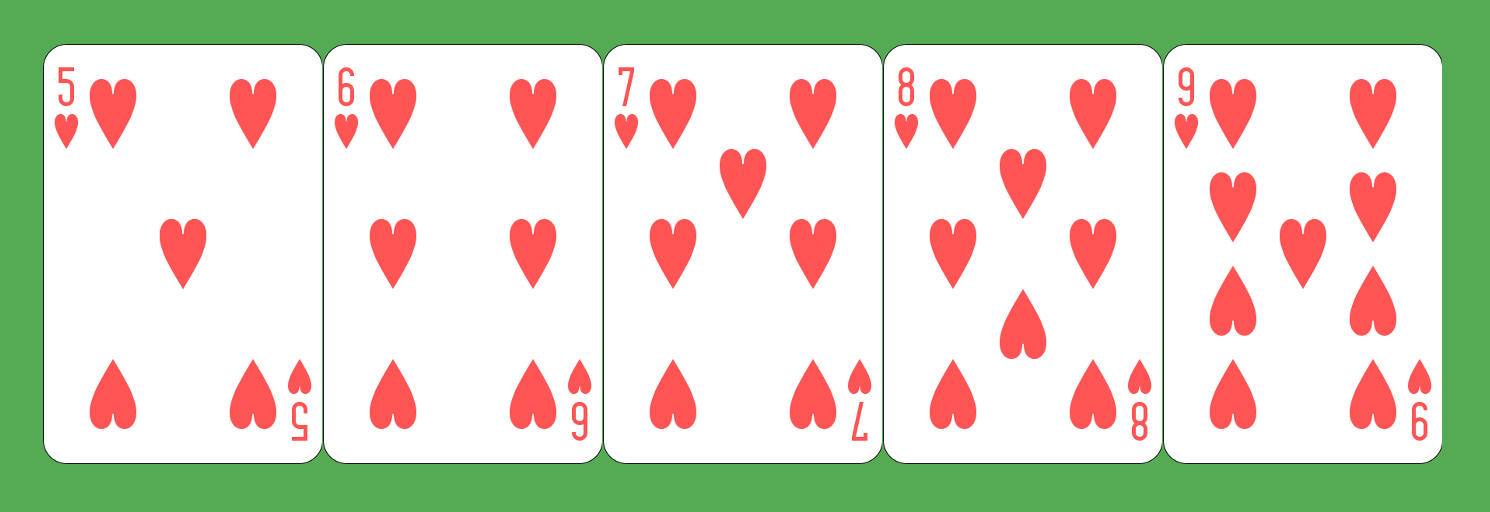
This is like a royal flush , however it can be with any card values. For example, 7-8-9-10-J, all of the same suit, would be a straight flush. This is another hand you’re very unlikely to see in a game
Four-of-a-Kind

This one is pretty self-explanatory, as it is when you manage to get four cards of the same value. This is a great hand, especially if you’ve made it with a pocket pair, as it can take other players completely by surprise.
Full House
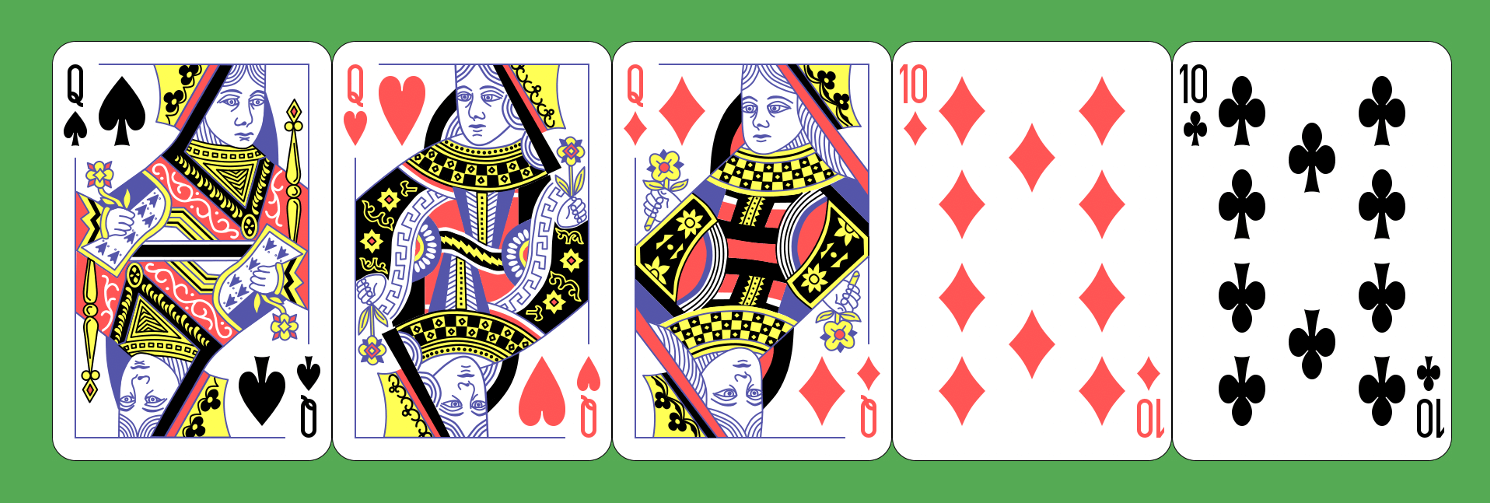
Now we get into the more commonly seen hands. A full house is when you get three cards of one value, and two cards of another value. An example would be the hand A-A-A-K-K.
Flush

A flush is when you get five cards of an identical suit. They do not need to be consecutive cards – if they were, you’d have a royal flush or straight flush. So, 2-5-6-J-A, all of which are clubs, would be a flush.
Straight
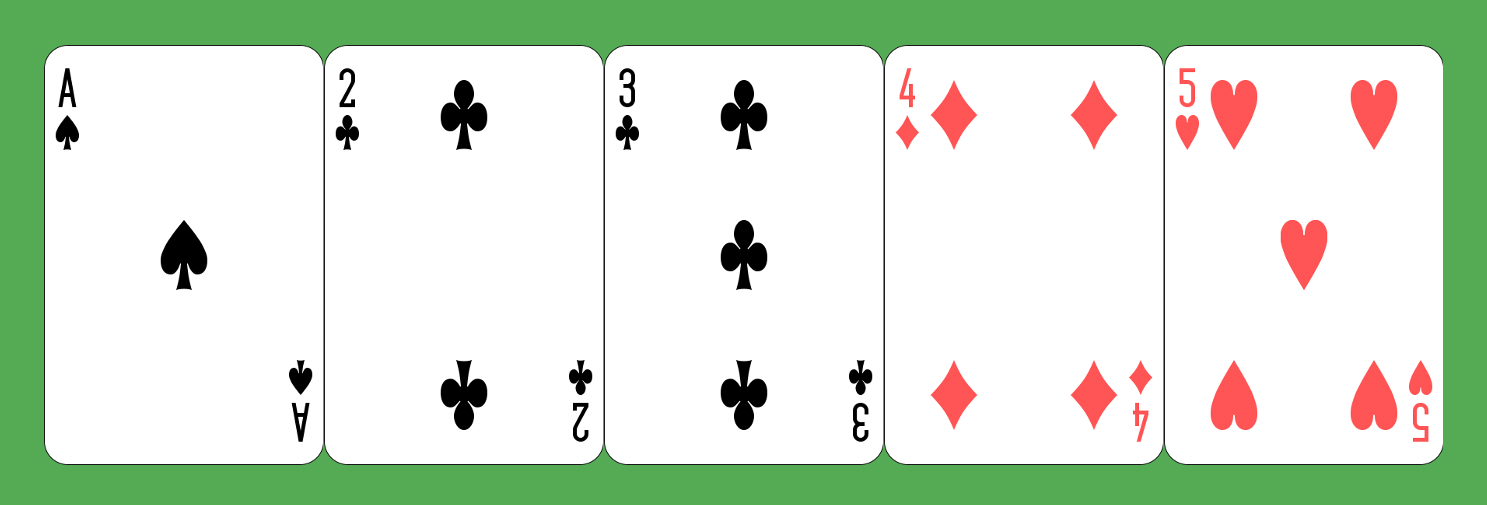
This is when you have five cards in numerical order, such as 5-6-7-8-9. They can all be of different suits – if they were all the same suit, you would have a royal flush or straight flush They can be strong, depending on the game situation.
Three-of-a-Kind

Quite simply, this is when you manage to get three cards of the same value in your hand. The other two cards will differ from each other. An example of the hand would be 8-8-8-J-A.
Two Pair
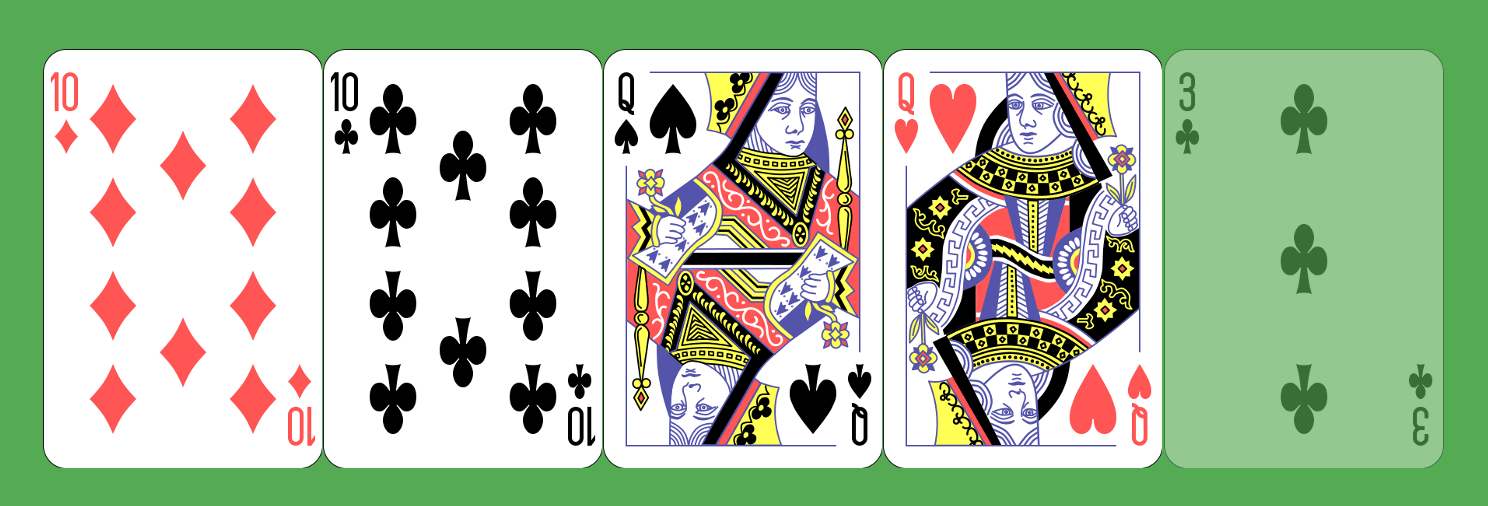
This hand happens when you get two different pairs. For example, your hand might be 2-2-7-7-A. it’s a common hand in poker games and you should see it plenty of times in one playing session
Pair
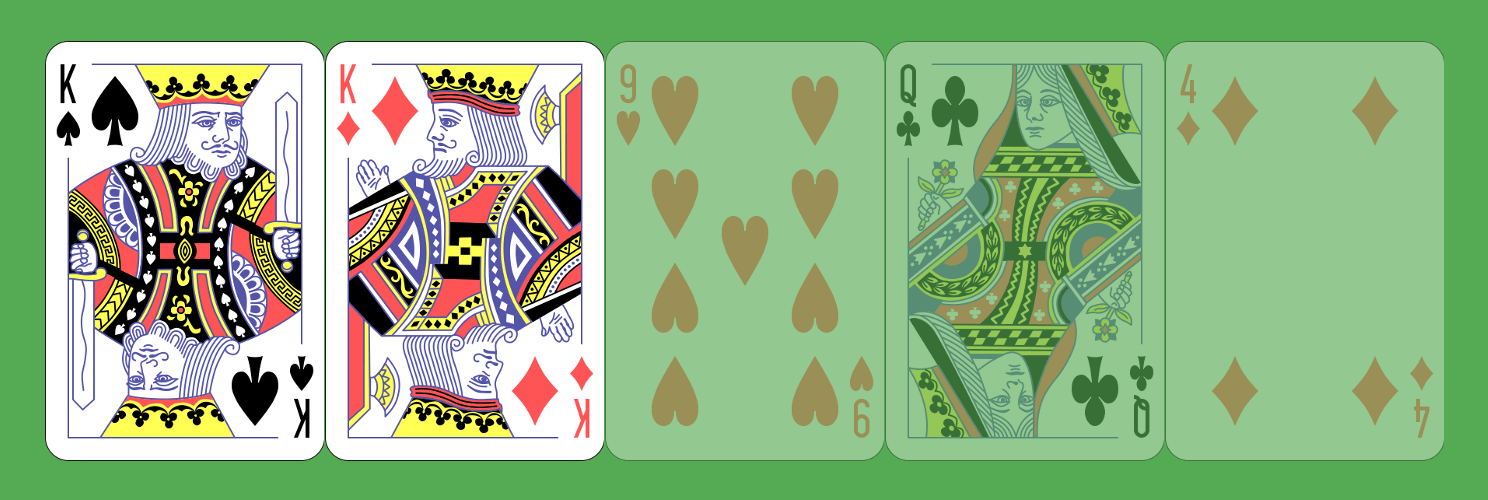
If you simply manage to get two cards of matching values in your hand, you’ll have a pair. An example would be 7-7-4-9-K. Despite being the second worst hand, it can be a winner, depending on the game situation.
High Card
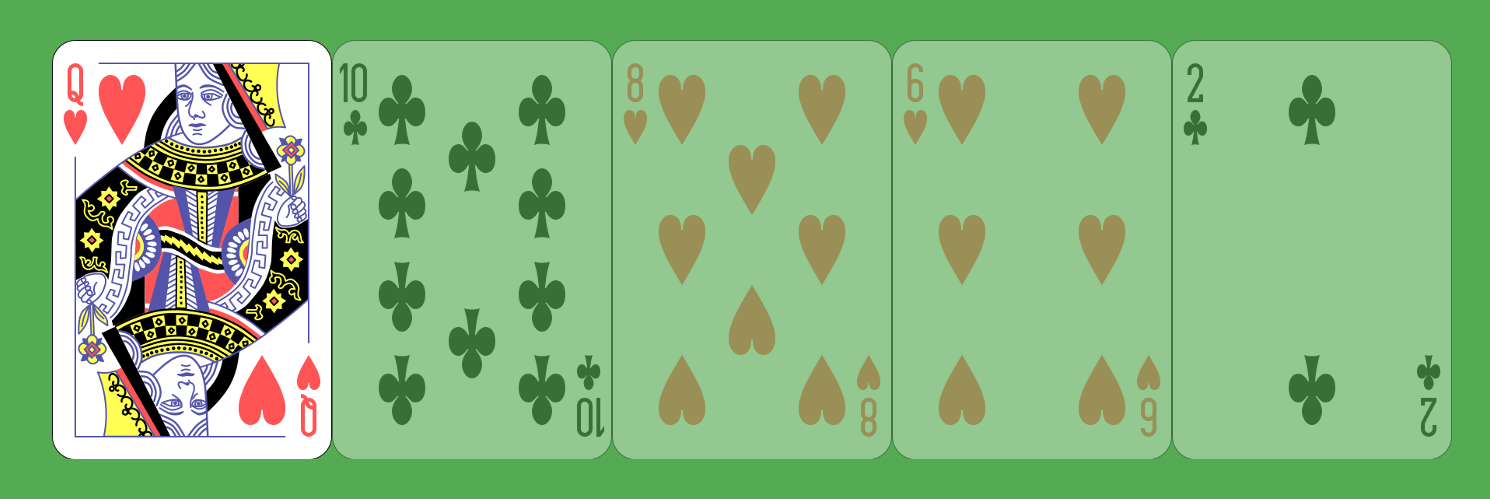
This hand basically means that you have nothing – not even a pair. This will be the hand you get most commonly. You’ll rarely win a hand with high card, unless you read the game and make a successful bluff
If you’re just starting in poker, read the above guide a few times and commit it to memory. You could even get someone to test you on the different hands! Alternatively, print out a poker hands chart and refer to it while you’re playing.
Remember that all hands are relative though. This means, for example, that two pair might be incredibly strong in one hand, but might be very weak in the next. It all depends on the cards on the table, as well as the cards in your and other players’ hands. The more you play, the more you’ll begin to understand how strong your hand really is . We’ll look at whether your hand is a good one later in this page.
Understanding Kickers and How They Affect Hand Rankings
Once you understand how the different card combinations are ranked, you need to take a look at kickers. These can be exceptionally important, as they can be the difference between you winning a pot or losing a pot to other called hands.
Kickers are essentially the spare cards in a hand. For example, if you had a hand of 2-2-A-A-K, you’d have two pair and the kicker would be the K. If someone else also gets the same two pair, the kicker will be used to determine the winner. Therefore, if they had 2-2-A-A-Q, you would win, as K is higher than Q.
What to Do When Two Players Have the Same Hand
It’s also important to understand how results are decided in the event that two or more players get the same type of hand, which happens regularly. Check out the handy guide below:
Royal Flush
It is only possible for two or more players to get a royal flush if all cards making the hand are dealt as community cards. If this happens, there is no way to separate the players and the hand is a tie.
Straight Flush
In the event that two players get a straight flush, the player with the highest card wins. This means, for example, that a straight flush of 7-8-9-10-J would beat a straight flush of 5-6-7-8-9.
Four-of-a-Kind
The player with the higher value four-of-a-kind wins. This means A-A-A-A-10 would beat K-K-K-K-10. If both players get the same four-of-a-kind, the player with the higher kicker wins.
Full House
The player with the higher three-of-a-kind wins. If both have the same, the player with the higher pair wins.
Flush
The player with the highest flush wins. For example, a player with a flush containing 5-6-9-10-A would beat a player with a flush containing 2-3-7-Q-K, as A is higher than K. If it’s a draw, the second highest card is used, then the third etc.
Straight
The player with the highest top card wins. This means that a straight of 7-8-9-10-J would beat a straight of 5-6-7-8-9, as J is higher than 9.
Three-of-a-Kind
If two or more players form sets (another word for three-of-a-kind), the player with the highest set will win. If two or more players have the same three-of-a-kind, the result is determined using the kickers.
Two Pair
If multiple players have two pair, the player with the highest pair wins. If this can’t separate players, the lower of the two pairs is used, and then the kicker.
Pair
If more than one player has the same pair, the highest kicker is used. If this is the same, the second highest kicker is used, then the third highest kicker.
High Card
Quite simply, the player with the highest card wins. If this doesn’t separate players, the second highest card is used, then the third etc.
Despite all the different tiebreakers used in poker, it is sometimes the case that two or more players can’t be separated, as they have exactly the same hands. If this is the case, the pot is split between the players, in proportion to the amount of money they’ve bet.
Is My Hand a Good One?
The most important question any poker player can answer when they’re playing is this: is my hand good enough to win? The answer to this question changes depending on circumstances, as you’ll see in the example below.
Imagine you have 7-8 in your hand, and the community cards are A-J-6-5-4. This would mean that you have a straight. What’s more, the straight is the highest possible hand (assuming the community cards don’t allow for a flush), meaning that your hand is an exceptionally good one. It’s not always the case that a straight is great though…
Imagine you have the same starting hand of 7-8, but this time the community cards are A-Q-J-10-9. You would still have a straight, as your five-card hand would be 8-9-10-J-Q. All it takes is someone to have a K though and your straight would be beaten. Therefore, your straight really isn’t as strong as the previous example.
The lesson here is a simple one: a hand is only strong when the situation is right. You have to look at your own cards and the community cards, plus you also have to consider what other players could have. This is the challenge of poker, and nobody is able to come to the right conclusion every time, not even the big-name pros taking part in multi-million-dollar tournaments !
Of course, you don’t always need a strong hand to win though, as if you can read the table well enough, you could manage to bluff your way to winning the pot. This is a more advanced strategy though – beginners still learning the hand rankings should not attempt bluffing until they have more experience of reading the game.
Common Misunderstandings in Hand Rankings
In the realm of poker, understanding hand rankings is fundamental, yet misconceptions often arise, particularly regarding the formation of straights. A common misunderstanding involves the criteria for a straight. To clarify, a straight in poker consists of five consecutive cards of any suit. This means the cards must follow a direct sequence, with no gaps in between. For instance, a hand like 8-9-10-Jack-Queen forms a valid straight because the cards are in uninterrupted sequential order.
Combinations such as 8-9-10-J-K or 7-8-10-K-A do not constitute valid straights. In these examples, there are gaps in the sequence (missing a Queen in the first and a 9 and Jack in the second), which breaks the continuity required for a straight. This misunderstanding can lead to overvaluing one's hand, thinking it's stronger than it actually is.
It’s also important to note that in poker, straights cannot "wrap around." That means a hand like Queen-King-Ace-2-3 is not a straight, as the sequence does not continue in order after the Ace. The Ace can either start a sequence (Ace-2-3-4-5) or end it (10-Jack-Queen-King-Ace), but it cannot link the high and low ends of the sequence together.
Understanding these nuances in hand rankings, especially for straights, is crucial for effective poker strategy and decision-making. Misinterpretations can lead to costly mistakes, so players should ensure they are clear on these rules to make informed and strategic plays at the poker table.
Incorporating strategies in your game
Poker strategy is as much about the cards in your hand as it is about the psychological interplay at the table. Effective strategy varies depending on the hand you're dealt and the read you have on your opponents. Let's delve into these aspects, along with some historical anecdotes that highlight the game's rich legacy.
Playing Different Hands:
- Strong Hands (e.g., High Pairs, A-K suited): With a strong starting hand, the strategy is typically to bet or raise to thin out the field. This not only increases the pot but also reduces the number of opponents who might catch a lucky flop. However, overconfidence with strong hands can be dangerous if the board develops unfavorably.
- Medium Strength Hands (e.g., Low Pairs, A-J offsuit): These hands are tricky. They have potential but are easily outdone. The strategy here is often to play cautiously, seeing the flop for a reasonable price and proceeding based on how the board improves your hand.
- Weak Hands: Generally, these should be folded unless you're in a good position or the game is very loose. However, occasionally playing a weak hand can disguise the strength of your future hands, adding a layer of unpredictability to your play.
Psychological Aspects
- Reading Opponents: Poker is as much a game of psychology as it is of chance and skill. Observing betting patterns, physical tells, and even players' use of language can provide clues about their hand strength. For example, a player who suddenly becomes talkative might be bluffing, while one who's unusually quiet might hold a strong hand.
- Bluffing and Misdirection: Effective bluffing can turn a weak hand into a winner. The key is in convincing opponents you have a stronger hand than you do. Similarly, showing a bluff occasionally can make your genuine bets more credible.
Historical Anecdotes:
- Doyle Brunson’s 10-2: In both 1976 and 1977, Doyle Brunson won the World Series of Poker Main Event with a 10-2 hand, turning it into a legendary hand in poker lore.
- Chris Moneymaker’s Bluff: In the 2003 World Series of Poker, Chris Moneymaker, an amateur player, bluffed seasoned pro Sammy Farha. This hand is credited with sparking the global poker boom, demonstrating how an unknown player could triumph over experienced competitors.
Understanding the strategic nuances of different hands, along with the psychological warfare that underpins poker, is key to excelling in the game. These historical anecdotes serve as a testament to the game's depth and the unexpected turns it can take.
FAQs
What’s the best possible hand in poker?

The best hand you can get in poker is a royal flush. This is a hand containing 10-J-Q-K-A, all of the same suit. If you have this hand, you can’t be beaten.
What are my chances of getting a royal flush?
When playing Texas hold’em, the chances of you getting a royal flush are 0.0032%. This means that the odds against you getting a royal flush while playing are 30,939:1, which explains why royal flushes are so rarely seen.
Do all forms of poker use the same hand rankings?
No, they don’t. While the majority of games see players trying to make the best possible five-card hand, there are some that challenge players to also get the lowest possible hand. For example, in Omaha Hi-Lo, half the pot is given to the player with the highest possible hand, and half to the player with the lowest possible hand.
What are the best and worst starting hands?
The best possible starting hand when playing Texas hold’em is A-A. If you get this hand, you should never fold before the flop (the first three community cards). The worst possible starting hand is 7-2 – this hand will be folded nearly every time.
Which suit has the highest value?
In poker, no suit has a higher value – all are equal. Whether players have cards of identical suits or different suits really doesn’t matter. So, for example, a pair of diamonds is treated as exactly the same as the same value pair of clubs – the winner would instead be decided using the kickers.
Do I have a flush if all my cards are the same color?
No, five identically colored cards don’t make a flush, unless they are all also the same suit. If you had two spades and three clubs in your hand, for example, you would not have a flush. However, if you had five clubs in your hand, you would have a flush.
Is it possible to have a hand containing three pairs?
No, it is not. While it is possible to make three pairs with the seven cards available, your hand only uses five of these cards, meaning there simply aren’t enough cards in your hand to make three pairs. If there were three possible pairs for you to choose from, you’d choose the highest two.
Popular Posts
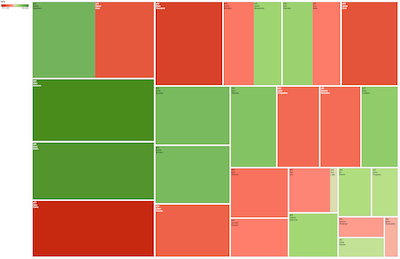
High Stakes Poker TV Show Statistics
Vizualise all the hands of the popular TV show High Stakes Poker. Visualize statistics like total tally, Vpip, PFR as well as the number of hands, per season and for all the seasons from your favorite poker players. more...
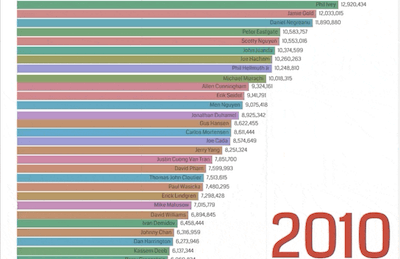
The Poker Money Race since 1971
Watch the top 100 of every year of each Money List since 1971 from The Hendon Mob and stacked them year after year to put them in a bar chart race. See some of the greatest rises and falls in poker history! more...


